A Guide to Photographing Tulip and Daffodil Fields
Tips for shooting compelling images of these magnificent beauties.
FLOWERSTULIPS AND DAFFODILS
3/17/20256 min read
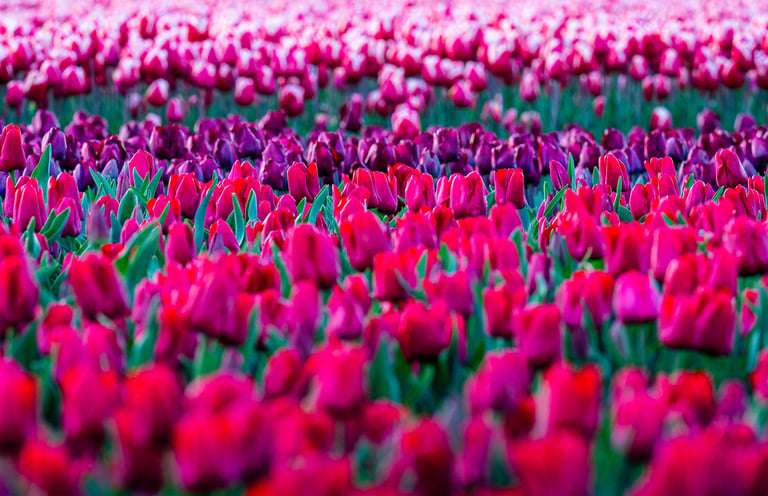

Tulip fields (and daffodils) are great subjects for spring landscape photography. Bold colors for miles in row after row are visually striking. But, turning it into an image that can hold the viewers attention takes more skill than just clicking the shutter button. Here are my top tips for beautiful photos for tulip and daffodil fields.
Where to Find Tulip and Daffodil Fields
One of the most renowned destinations for tulip and daffodil fields is the Skagit Valley in Washington State. Every spring, this locale transforms into a colorful tapestry of tulip and daffodil fields, drawing thousands of visitors and photographers alike. The number of fields and farms provides ample opportunities for stunning compositions. The vibrant colors contrast beautifully against the backdrop of snow-capped mountains, creating a picturesque setting that is hard to match.
Skagit Valley hosts the annual Skagit Valley Tulip Festival, an event that lasts through the month of April, celebrating the bloom of these flowers. Their website has a bloom tracker that can give you the latest updates. They also have a map that shows where farms and fields are located. Farms have ticketed displays you can visit; some even have special "photographer tickets" if you'd like to enter at sunrise. But there are fields throughout the valley that you can see for free. Just be conscious of rules for parking; not all roads have a shoulder and there are no parking signs in several locations. If you'd like to know one of my favorite field locations, sign up for my newsletter below.
The Wooden Shoe Tulip Farm in Oregon is another popular site, featuring sprawling fields with an impressive variety of tulip species. I have not been to this one yet, but I've seen stunning photos of tulips with hot air balloons and tractors from this location.
When to Go
Daffodils generally begin to bloom in March, and tulips typically reach their peak bloom in April. I like to watch the flowers in my neighborhood to get an idea what to expect. The website for the Skagit Valley Tulip festival will have bloom updates. You can also check out social media of the local farms, like Roozengaarde.
The key to getting the best shots lies not only in the month you choose to visit but also in the specific timing. Low wind days are recommended because they minimize flower movement. Moving flowers will mean you require a faster shutter speed, and in that case you may have to compromise on aperture and/or ISO to get the right exposure. It also makes any shots that require focus stacking impossible.
Additionally, shooting after rain showers can offer unique photographic compositions. Reflections of tulips in the water pooled in the field furrows is a classic composition. And of course, consider the lighting conditions. The golden hours of sunrise and sunset provide soft, flattering light that can make tulips and daffodils appear even more striking. Planning your photography sessions around these times enhances the aesthetic of your photographs, a much more flattering looking than the harsh, contrasty look of bright midday light on a clear day.
Compositions
When photographing tulip and daffodil fields, applying specific compositional techniques can significantly enhance the visual impact of your images. Rather than just snapping a shot of the whole field, seek to find compositions that draw the viewer in.
One effective method is to focus in on a smaller area of the field for a more intimate view. One way to do this is to focus in on a single odd-colored tulip amidst a sea of similarly colored flowers. The juxtaposition of colors can be eye catching, making your photograph more engaging. It also can conjure some emotions by relating to being that outlier in a sea of others.
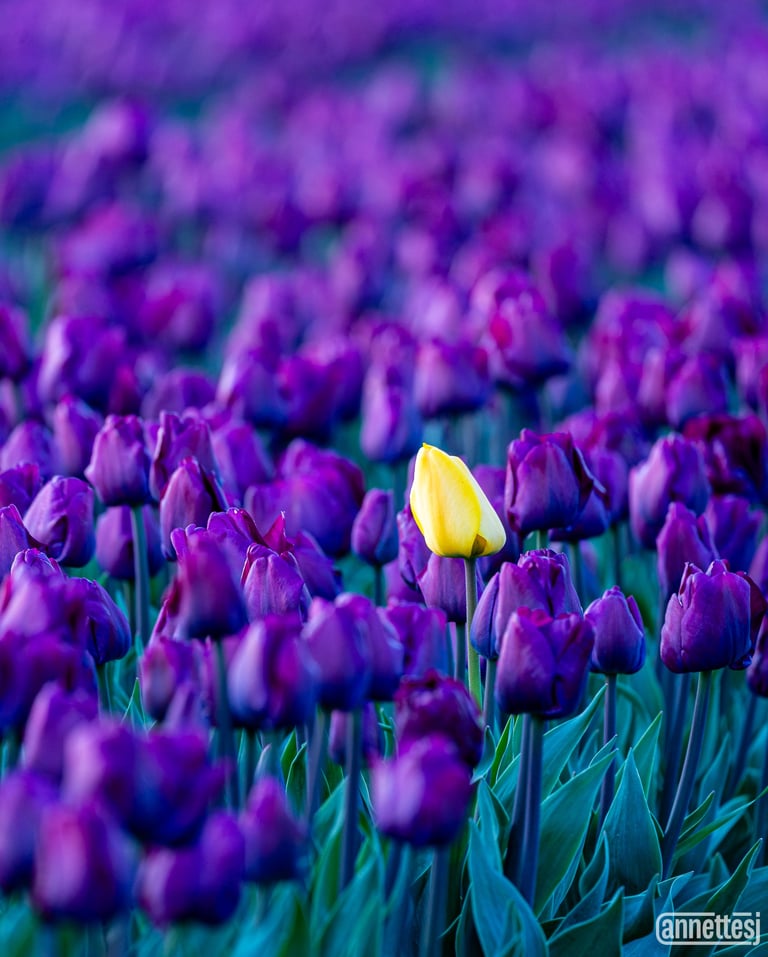

Sony A7RIII, 400 mm, 1/6 sec at f/6.3, ISO 500
Another vital compositional technique involves the use of leading lines. The lines of fields are great for this. To guide the viewer's eyes through your photograph, consider positioning the field lines in such a way that they create pathways or lines leading toward a distant horizon or interesting background elements. This could be distant mountains, a barn, or an amazing sunset or sunrise. Utilizing these lines effectively can convey depth, enhancing the three-dimensionality of your image and inviting viewers to wander through the vibrant landscape encapsulated within your shot.
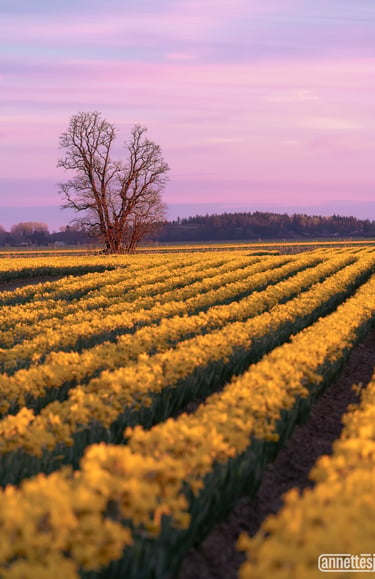

Sony A7RIII, 200 mm, 1/15 sec at f/8.0, ISO 125
Additionally, capturing reflections of tulips in water puddles can introduce an element of symmetry to your photographs. This approach not only enhances the aesthetic quality but also adds visual intrigue, presenting a more layered photograph. It also tells a story of spring and recent rains helping to bring these flowers to life.
By considering these compositional techniques, you can create remarkable images that showcase the beauty of tulip and daffodil fields. Engaging contrasts, leading lines, and reflective surfaces together can transform standard flower photography into captivating visual narratives.
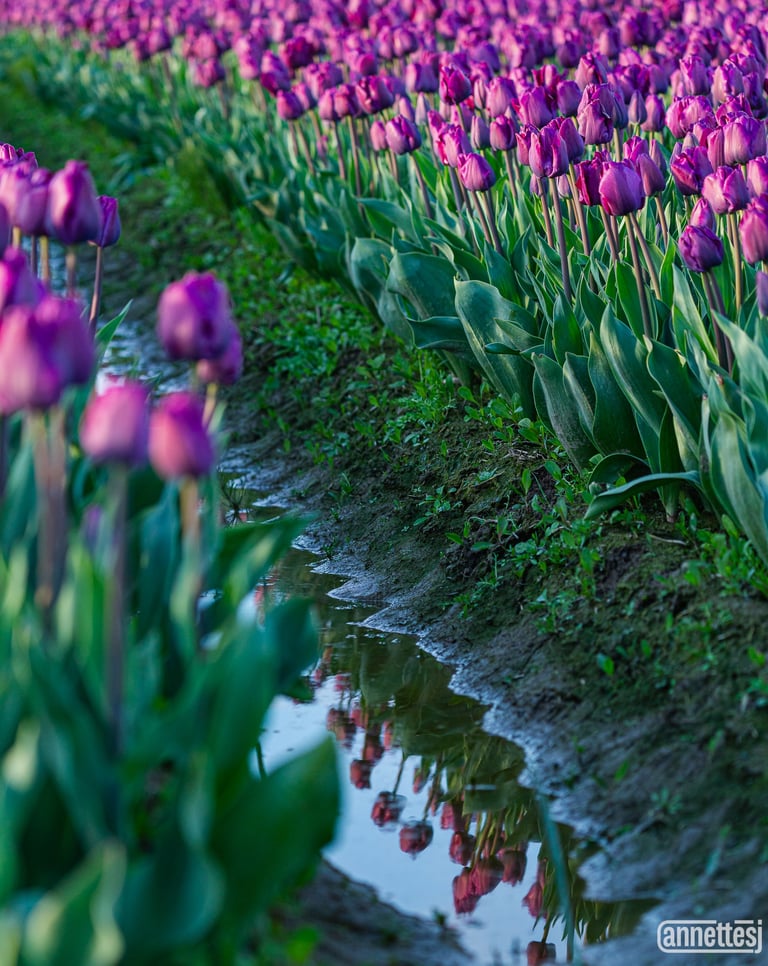

Sony A7RIII, 100 mm, 1/400 sec at f/4.5, ISO 400
Camera Settings for Flower Photography
When photographing tulip and daffodil fields, selecting the right camera settings is crucial to properly exposed, in focus images.
If it is a still day with little wind, I first consider my aperture and ISO. If I have a composition where I want the entire image in focus, I choose a small aperture such as f/11 or even f/16 depending on how much I have in the near foreground. I choose a narrow enough aperture to get everything I want in focus, but not so narrow that diffraction starts to impact image quality. But, more often in some of these compositions, I want only part of the scene in focus. In that case, I choose a very wide aperture such as f/6.3 or even wider. This is a really nice technique for the odd color tulip in a field, so you can bring focus to just that one tulip. A wider aperture (such as f/2.8 to f/6.3) can create a beautiful bokeh effect, allowing the flowers to stand out sharply against a softly blurred background. I then set my aperture as low as possible (usually ISO 100) and adjust my shutter speed to balance the exposure. I am usually using a tripod.
If there is a lot of movement on a windy day, I consider the shutter speed first. It's best to experiment a bit to see what speed you need to freeze motion. A setting of 1/250s or faster can effectively capture the flowers without any motion blur. I then set my aperture for the depth of field I require, and adjust ISO as needed to balance the exposure. If ISO is high, it becomes more important then to experiment with what shutter speed you really need to freeze motion. If you can let in more light with a slower shutter speed, your ISO can improve (lower ISO, less noise).
Gear
I shoot with my Sony A7RV mirrorless. The lens I use most often for tulip fields is actually a telephoto, Sony FE 100-400 mm. This allows for focusing in on subjects with a nice bokeh, and also for capturing subjects in the distance like barns and mountains. You can get some great compression effects with layers of color in the foreground and your supporting subject in the background.
Don't forget your tripod, memory card, and extra batteries.
Time to take some photos!
I love this time of year! It's fun to explore the valley and see what fields lend themselves to interesting compositions. It's worth driving around a bit in the day to scout your favorite locations for sunset (or sunrise the next day). There is a lot to see, so having some compositions in mind before you go is always helpful.
You can check out prints of my favorite Spring flower photos of tulips and more here!
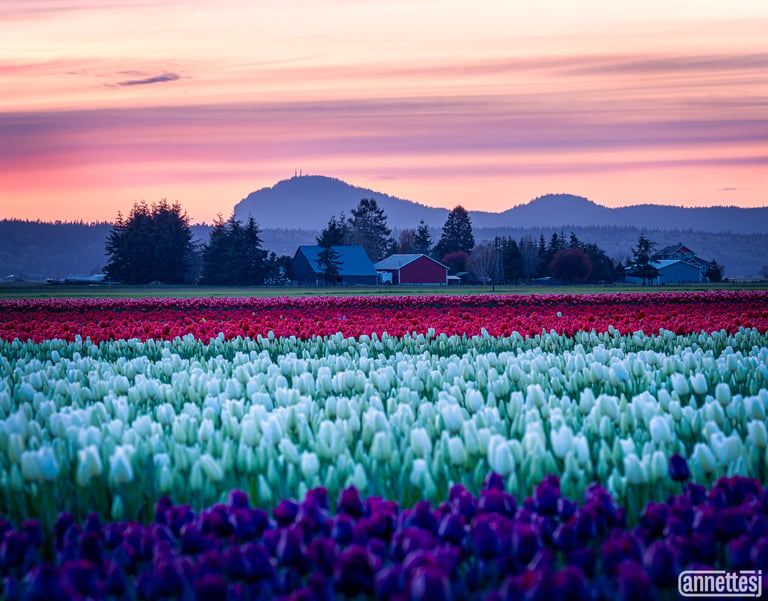

Contacts
annette@annettesjphoto.com
Socials
Copyright © 2023-2025 Annette Stiers Jones Photography. All rights reserved.
